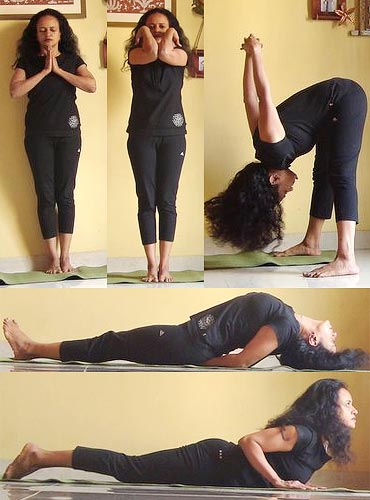
As the mood of Valentine and its association with our heart continues, we can look to what yoga has to say about this important plexus and how we may heal ourselves through love and acceptance.
In yoga, the heart plexus is referred to as the anahata chakra (wheel/plexus). It is associated with higher impulses. Except in sages, in most of us it is said to be either overflowing or blocked. In ones where the heart is said to overflow are who give to others at the expense of themselves and often hurt themselves in the process.
In those in whom it is blocked, it is said to indicate selfishness and lack of self-acceptance. Both are conditions that can, according to yoga, cause severe illness in the circulatory system, the immune system, and the lungs. Some of the common ailments associated with a dysfunctional heart plexus are asthma, coronary disease, respiratory and weakened immunity.
Practices that work on the heart chakra are said to bring the chakra back into a state of balance, when its flow is equitable and smooth.
Shameem Akthar, yoga acharya trained with the international Sivananda Yoga Vedanta Center, shows you five poses that work on your heart centre.
These poses, though easy to practice, need guidance of a yoga teacher. Attempt them only if you have some yoga practice already on. For more on Shameem's yoga writings and workshops, go to https://jaisivananda.blogspot.com
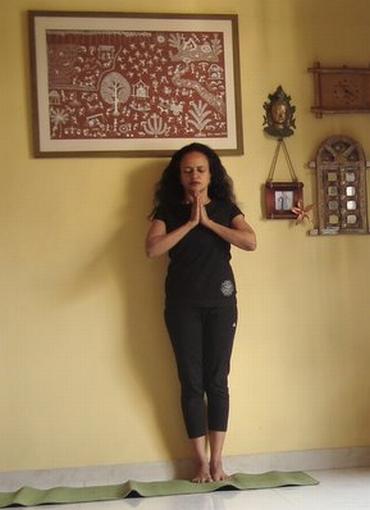
Stand up straight. Feet should touch lightly from inside. Keep both palms together at the chest, as shown. Shut eyes. Hold this pose for as long as possible.
If you feel the balance is becoming shaky, you may open your eyes for a few seconds to get your bearings before shutting them back. Try to hold this for a minute at least after a few weeks.
To keep a count of the time, you may count backwards, starting from 60, counting down to zero.
Points to note: Though a seemingly simple pose it is tough and calls for the deliate sense of balance. So, it needs regular practice before perfection is reached.
If you feel you are shaking a lot in this pose, lean lightly against the wall for support in the initial stages. However, move out from such props after a few weeks or even days.
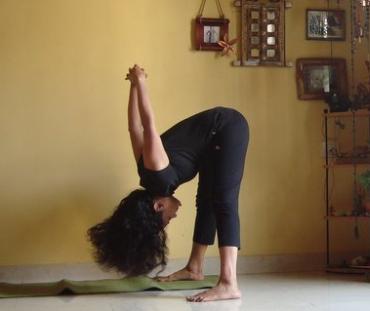
Stand with legs a meter apart. Flare right foot out, left slightly turned inward. Inhale, grasping hands behind, interlocking fingers.
Exhale, lunging to right, lower head to reach forehead to knee. The back leg should be straight. Straighten hands behind also as high as possible.
Continue normal breathing throughout. Release return to center to repeat for the other side.
Benefits: Calms. Tones spinals. Relieves emotional tensions.
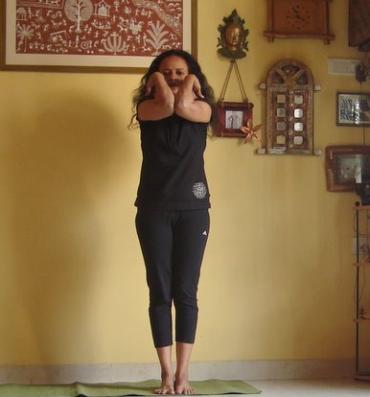
Stand up straight (may be also done seated). Place each hand, fingers lightly touching either shoulder as shown. Each elbow must be pointed straight out.
Roll the elbows in front, bringing them as close as possible, keeping chest erect. Do five to ten times. Rest, then roll the shoulders backwards five to ten times.
Benefits: Releases tension lodged in the upper body, especially the neck and shoulder region. Offer relief in frozen shoulder and neck problems. Is a good immune booster and improves respiration.
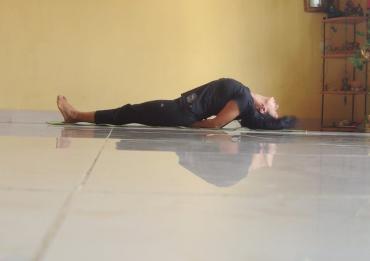
Lie on your back. Placing palms down on the floor beside the body, push hands under the hips. Elbows should be as close as possible to each other. Inhale, raising your head as if to look at the toes. Exhale.
Inhale deeply. Now slowly tilt head back so your neck arches, touching the crown to the floor. Now breathing evenly, introduce a few corrections, such as perfecting the arch by pushing up your chest further; resting the entire upper body on your elbow and lower arms. Ideally you should look back.
Benefits: Is therapeutic in diabetes, obesity, respiratory ailments, spinal problems. Those with vertigo may find this tough. You can sensitise yourself and phase your learning of the pose, by using a bolster.
This pose is called a face-freshener because it boosts respiration, blood circulation and works out the subtle muscles of the face. It also works on the thyroid gland, involved with metabolism. And the arch at the neck improves voice.
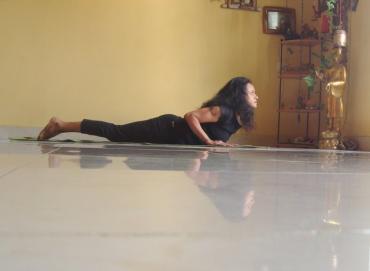
Lie on stomach with chin on floor and palms either side of shoulder. Inhale. Raise chin and shoulder off the floor arching back. Eyes should look up at the ceiling, stomach should remain pressed on the floor so the arch is emphasized at the lower back. Hold for a few seconds initially.
Breathe normally throughout. To return to starting position, exhale and lower back gently to the floor. Attempt thrice. With a few weeks or even months of practice, you can do this pose only once but extend time to half a minute or more in the final position.
Avoid: In case of abdominal inflammations and flare-ups and severe lower backache and hyper-thyroidism.
Benefits: Same as above. It also helps with weight-loss due to pressure on thyroid at throat. Therapeutic value in diabetes due to pressure on abdomen.